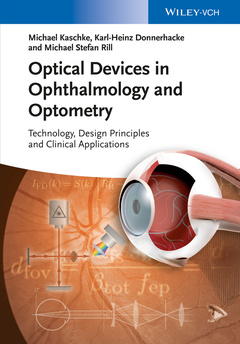Optical Devices in Ophthalmology and Optometry Technology, Design Principles and Clinical Applications
Auteurs : Kaschke Michael, Donnerhacke Karl-Heinz, Rill Michael Stefan

Medical technology is a fast growing field. Optical Devices in Ophthalmology and Optometry gives a comprehensive review of modern optical technologies in ophthalmology and optometry alongside their clinical deployment. It bridges the technology and clinical domains and will be suitable in both technical and clinical environments. The book introduces and develops basic physical methods (in optics, photonics, and metrology) and their applications in the design of optical systems for use in ophthalmic medical technology. Medical applications described in detail demonstrate the advantage of utilizing optical-photonic methods. Exercises and solutions for each chapter help understand and apply basic principles and methods.
From the contents:
- Structure and Function of the Human Eye
- Optics of the Human Eye
- Visual Disorders and Major Eye Diseases
- Introduction to Ophthalmic Diagnosis and Imaging
- Determination of the Refractive Status of the Eye
- Optical Visualization, Imaging, and Structural Analysis
- Optical Coherence Methods for Three-Dimensional Visualization and Structural Analysis
- Functional Diagnostics
- Laser???Tissue Interaction
- Laser Systems for Treatment of Eye Diseases and Refractive Errors
1. Structure and Function
2. Optics of the Human Eye
3. Visual Disorders and Major Eye Diseases
PART II
4. Introduction to Ophthalmic Diagnosis and Imaging
5. Determination of the Refractive Status of the Eye
6. Optical Visualization, Imaging, and Structural Analysis
7. Optical Coherence Methods for Three-Dimensional Visualization and Structural Analysis
8. Functional Diagnostics
PART III
9. Laser-Tissue Interaction
10. Laser Systems for Treatment of Eye Diseases and Refractive Errors
PART IV
A. Basics of Optics
B. Basics of Laser Systems
C. Used Variables and Abbreviations
Michael Kaschke received his Ph.D. degree from the Friedrich Schiller University of Jena in 1986 for his research in the field of ultra-short light pulses and ultrafast spectroscopy. Before joining Carl Zeiss, he was a research scientist at Max-Born-Institute Berlin, Max-Planck-Institute G??ttingen, and invited visiting scientist at IBM Research Center York- town Heights, N.Y., working on high-power fs-laser pulses and their matter interaction. He joined the Carl Zeiss Group in 1992 and has held since then several research and management positions in the company, predominantly in the medical business. Michael Kaschke is currently President and CEO of the Carl Zeiss Group, a technology leader in optics, optoelectronic, and medical tech- nology headquartered in Oberkochen, Germany. He is also a professor for medical technology at the Karlsruhe Institute of Technology, Germany.
Karl-Heinz Donnerhacke received his Ph.D. degree from the Friedrich Schiller University of Jena, Germany, in 1976 for his research in the field of high power gas lasers. He spent over 25 years of his professional career working at Carl Zeiss in laser development and laser application in medicine. Until his retirement he was Director of R&D in the Ophthalmic Diagnostic Instruments Division of Carl Zeiss/Carl Zeiss Meditec for almost 20 years. Since 2003, Karl-Heinz Donnerhacke has been an adjunct professor for ophthalmic technology at the Ernst Abbe University of Applied Sciences Jena, Germany and the Technical University Ilmenau, Germany. Currently he also works as a technology consultant in the field of ophthalmic devices.
Michael Stefan Rill received his Ph.D. degree from the Institute of Applied Physics at the Karlsruhe Institute of Technology, Germany, in 2010 for his research in the field of 3D photonic metamaterials. He joined Carl Zeiss in Oberkochen, Germany as a scientific assistant to the CEO in 2010. In 2013 Michael Stefan Rill assume
Date de parution : 03-2014
Ouvrage de 638 p.
17.8x25.2 cm
Thèmes d’Optical Devices in Ophthalmology and Optometry :
Mots-clés :
fast; technology; growing; medical; ophthalmology; modern; optical; comprehensive; technologies; review; devices; technical; suitable; physical methods; optics; ophthalmic; design; systems; use; applications; detail



